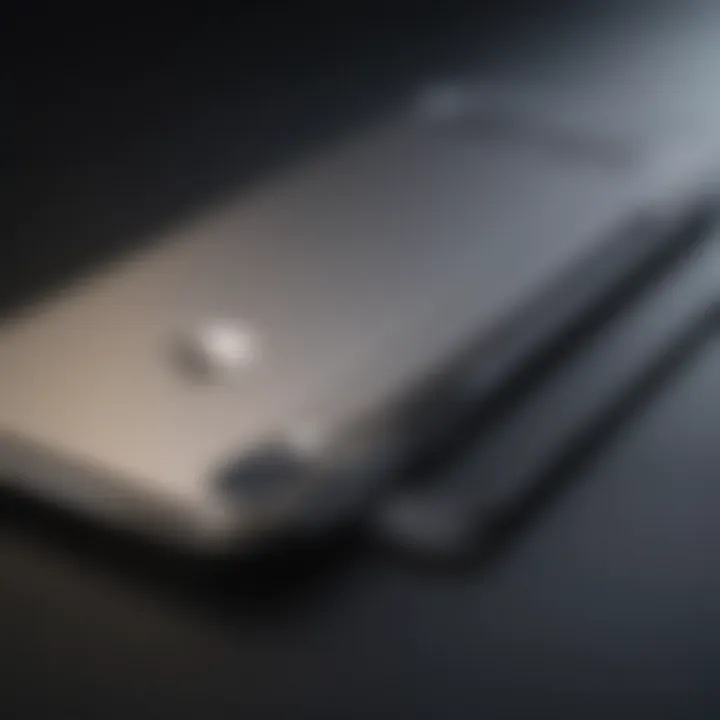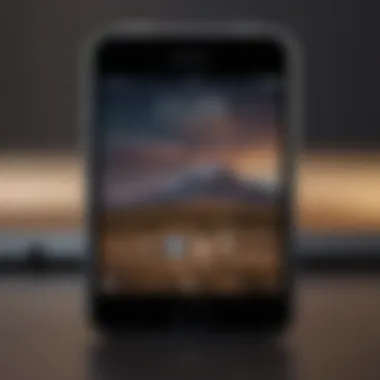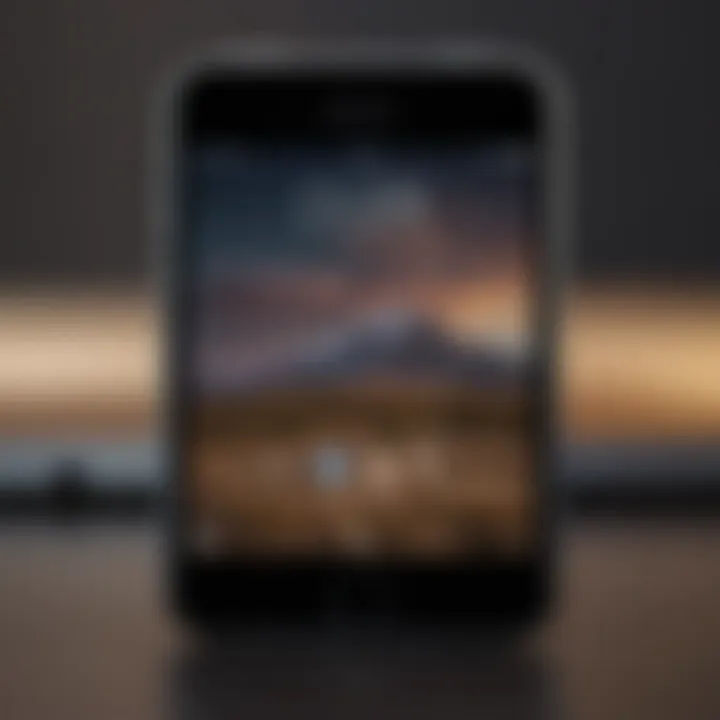Exploring the iPhone: Key Features and Market Insights


Product Overview
Preamble to the Apple product being discussed
The iPhone symbolizes a significant evolution in mobile technology. Since its debut in 2007, it has transformed the way people connect and communicate. Apple continually raises the bar with each iteration, impacting design, functionality, and user experience in the smartphone market.
Key features and specifications
The iPhone's key features span a wide array. A few notable specifications include:
- Display: High-resolution Retina display with vibrant colors and excellent brightness levels.
- Camera: Superior optical systems that allow for stunning photos and videos in various environments.
- Processor: Apple's in-house chips, such as the A14 Bionic and A15 Bionic, deliver exceptional performance.
- Operating System: iOS assures an intuitive user experience, with regular updates that enhance functionality and security.
Design and aesthetics
The design highlights premium materials like glass and aluminum. Apple prioritizes a sleek and seamless aesthetic. Various color options cater to different preferences, while the ergonomics are engineered to fit comfortably in hand. The iconic notch on the newer designs offers an edgy look while housing vital camera technologies.
Performance and User Experience
Performance benchmarks
Performance benchmarks consistently show that the latest iPhone models excel. The gains in processing speed, graphical performance, and efficiency standings validate this status.
User interface and software capabilities
A refined user interface enables seamless navigation across applications. iOS's consistent updates include features like FaceID, various Siri optimizations, and an elaborate App Store. Each provides users with rich customizations.
User experiences and feedback
User feedback generally indicates high satisfaction levels. The integration of hardware and software tends to lead to fewer technical issues compared to other brands. However, some may frown upon the closed ecosystem restriction.
Comparison with Previous Models or Competitors
Advancements and improvements from previous models
Comparing models reveals notable improvements in battery life, camera quality, and overall performance. Recent devices cycle through meaningful upgrades not simply adding novelty but enhancing usability.
Competitive analysis with other similar products
Facing off against brands like Samsung and Google, Apple often emphasizes user privacy and ecosystem reliability. Pundits suggest Apple leads in brand loyalty even if competitors provide specific features at times.
Value proposition
Apple markets the iPhone as a comprehensive solution. Enhanced security, ease of use, and a rich app ecosystem contribute to a sustained expectation for a premium price justification.
Tips and Tricks
How-to guides and tutorials for optimizing the Apple product's performance
To optimize the iPhone experience, users should regularly update their devices. Furthermore, managing storage and knowing iOS shortcuts can improve workflow.
Hidden features and functionalities
Users often overlook various hidden features like battery optimization tactics found in 'Settings.’ Mastering Siri remains underused but holds extensive potential.
Troubleshooting common issues
Common issues often arise concerning battery drainage or camera glitches. Many issues can be resolved via an easy software reset or by adjusting certain settings found in the settings tab.


Latest Updates and News
Recent developments in software updates and new features
Apple's ongoing dedication to software performance yields biannual feature updates vibrant with new app functionalities and security tightness. Recent privacy features stand out.
Industry news and rumors surrounding upcoming products
Speculators often circulate news about iPhone releases round the mid-autumn, highlighting anticipated technologies yet to be tested broadly.
Events and announcements from Apple
Apple's periodic events inform users of new products and advancements. These announcements play a significant role in crafting consumer anticipation.
Ultimately, the iPhone emerges as a key player not merely through its technical flourishes but through its deep integration into contemporary life.
Prolusion to the iPhone
The iPhone stands as a monumental achievement in the evolution of technology. Since its inception, it has reshaped how individuals communicate and interact with their digital environments. A discussion about the iPhone is a discussion about an evolving legacy that integrates innovation, connection, and style. This section sets the groundwork for understanding the iPhone’s significance.
The Beginning of the iPhone Era
In January 2007, Apple unveiled the first generation iPhone, an event that marked the commencement of a new era in mobile communications. With a unique combination of an iPod, a mobile phone, and an internet communicator, it redefined user expectations. Many observers noted the iPhone's multi-touch interface and minimalist design, creating a paradigm shift in smartphone technology.
Initially, the device faced skepticism. Critics questioned the absence of a physical keyboard and the high price point. Nevertheless, the innovation it presented spoke louder. Over the years, Apple incrementally added features and capabilities, each version building upon the previous, sparking interest in what could undoubtedly be considered a disruptive product.
Current Evolution of iPhone Models
From the original model, the iPhone lineup has grown to include various options catering to different demographics. Presently, Apple offers flagship products alongside budget-friendly variants. Each new release garners much attention, showcasing enhancements such as improvements in photography, processing power, and battery efficiency.
For instance, the introduction of the Super Retina XDR display in newer models has brought screen quality to new heights, allowing for stunning visuals. Furthermore, advancements in artificial intelligence have integrated seamlessly into everyday tasks, increasing productivity and convenience.
With features like enhanced 5G capabilities, biometric recognition, and increasingly sophisticated apps, today’s iPhones are more than just phones. They represent a blend of hardware and software intricacies that cater to both tech enthusiasts and casual users alike. Understanding the evolving nature of the iPhone is essential for grasping its role in contemporary technology and society.
The iPhone has transcended being just a communication tool; it has become a defining feature of modern life.
Key Features of the iPhone
Understanding the key features of the iPhone is essential to grasping its place in the technology landscape. These features not only define the product itself but also influence consumer choices and shape user experiences. As Apple adheres to its philosophy of blending functionality and design, key elements emerge that highlight the iPhone’s place in both personal utilities and an expanding ecosystem. The superficial allure is complemented by underlying advancements that speak to both performance and user-led innovations in technology.
Design Aesthetics and Build Quality
The design of the iPhone has evolved dramatically since its inception in 2007. Each iteration reflects Apple's commitment to superior quality and artisan craftsmanship. The use of premium materials, such as aerospace-grade aluminum and surgical-grade stainless steel, aligns with the product’s premium branding.
In modern models, a minimilistic approach speaks volumes in enhancing user engagement. The tenets of balance, symmetry, and eye-catching finishes invite enthusiasts and casual users alike. Glass backs not only give elegance but also enable the wireless charging feature, continuously addressing both form and function.
This commitment extends beyond just looks. An improved build quality retains durability against the elements and potential drops. Water resistance offered in models—such as iPhone 12 and later—attests to Apple’s responsiveness to consumer needs. Enabling secure grips and reliable feel in hand ensures usability remains prioritized, fostering ongoing customer loyalty.
Display Technology Advancements
The iPhone display technology serves as a pivotal aspect of its appeal, prominently showcasing Apple's innovative edge. The introduction of Retina display, and subsequently Super Retina display, sets new standards for resolution sharpness and color fidelity in the smartphone market.
Beyond resolution, advancements in OLED technology provide deeper blacks and a broader color gamut, enriching multimedia and user experience. Non-reflective screens also facilitate visibility under direct sunlight, ensuring users maintain access irrespective of their environment. Models such as iPhone 14 Pro set benchmarks with ProMotion technology allowing adaptive refresh rates up to 120Hz, bringing smooth visuals during advanced interactions. This dynamic feature underpins fluid scrolling and responsiveness in gaming and content consumption.
Camera Innovations
The iterative improvements in the iPhone’s camera capabilities are one of the most compelling reasons for its continued market dominance. Through software enhancements and hardware advancements, the iPhone camera system does more than capture images—it creates experiences.
Growing from a single lens to complex multi-camera setups allows for varied photography techniques. The introduction of Night mode, Deep Fusion technology, and computational photography demonstrates Apple's intent to elevate user creativity. Live Photos and seamless editing tools enrich interactions post-capture, making photography less about the technical and more about self-expression.


Traditional strengths are augmented, with each new iPhone enhancing low-light shots and smart HDR features, transcending mere consumer tools to embrace artistry and capability. The focus on video also rings notably with ProRAW and cinematic mode available in the iPhone 13 series, catering additionally to videographers in blending professional quality into an accessible format.
Battery Life and Performance
Battery life and performance form foundational attributes that define the iPhone user experience. Over the years, several engineering feats enable better power management, sustained performance under strain, and daily usability without constant interruptions.
The introduction of efficient chips like the A15 Bionic merges performance with power efficiency, ensuring conducive multitasking capability. Battery science continues to improve, aiming to extend daily usage without elongated recharging sessions. Users report substantial increases in screen-on time, enabling more extensive phone activities without the constraints of managing power.
FResponse for enhancing experiences include optimized charging landscapes freeing users from extended attachment to power slots—improving real-world accessibility. This integration enforces user reliance on the device without fear of depletion affecting productivity.
User Experience and Interface
User experience (UX) and interface design play a critical role in defining the iPhone as a preferred device among millions of users. These elements not only dictate how a user interacts with the device but also shape overall satisfaction and productivity. A well-designed interface can enhance usability as it allows users to easily navigate complex tasks with minimal effort.
The iOS operating system is fundamentally geared toward intuitive use. This design philosophy enables users to efficiently utilize various features and applications. From the immediate accessibility of apps in the home screen to the seamless integration across Apple's ecosystem, every aspect is considered to reshape user interaction positively.
iOS Ecosystem Overview
The iOS ecosystem constitutes the foundation of user experience on the iPhone. It integrates not just the hardware but also the software, applications, and services that respond to diverse needs. Primarily, this close interlinkage among iPhone, iPads, Macs, and other Apple devices creates an aura of connectivity. Every device contributes to an overarching experience by enabling features like Handoff and Continuity, which allow users to switch tasks smoothly across their devices.
High compatibility with third-party apps also enhances UX. Developers design applications that leverage iOS capabilities to provide a unique experience. This includes but is not limited to gaming, productivity apps, healthcare, and education. For instance, popular apps such as Instagram and Microsoft Office are optimized for iOS to ensure adaptive showings of rich functionalities in complete ease, which increases user loyalty.
Moreover, consistent updates of iOS keep users engaged and boost security. Each iteration introduces new features like augmented reality tools, improved messaging systems, and tools to manage digital wellbeing, all reinforcing why a positive and progressive user experience remains a top priority.
Navigation and Accessibility Features
Navigation within the iPhone system is designed to be user-friendly and adaptive for a range of skill levels and physical abilities. Apple's longstanding dedication to accessibility resonates through several features tailored to address specific user requirements.
Detailed between these features, VoiceOver allows visually impaired users to understand what's onscreen, enhancing independent use. Another feature, Switch Control, permits users with limited mobility to navigate through a series of customizable gestures. Such accessibility options enable broader audience adoption, setting a standard in the smartphone industry.
In-depth settings like Touch accommodations provide ways for users to alter touch controls based on personal preferences. Touch, hold, or swipe can easily adjust to unique input needs, thereby making the interface usable for everyone. Many features reactive to user customization further support varied preferences and minimize navigation hurdles, promoting inclusivity.
In summary, feedback consistently suggests that an optimal user experience hinges on consideration for all types of users, ensuring a universally appealing interface. As trends in technology evolve, fine-tuning these features remains key to keeping the iPhone at the surface of innovation and user satisfaction.
Comparative Analysis
Comparative analysis is an essential part of understanding the iPhone within the broader context of mobile technology. This section will dissect significant similarities and distinctions between the iPhone and other devices, particularly Android models. Given the inherent diversity in the smartphone industry, this analysis aids consumers and tech professionals in making firm decisions about their technological investments. It also sheds light on strategic positioning, market trends, and user preferences.
iPhone vs.
Android Devices
The debate between iPhone and Android devices is persistent and vibrant. Each platform has its ardent supporters and unique selling points.
- Operating System: iPhones operate on iOS, known for its smooth, seamless user experience. iOS updates tend to be rolled out more uniformly across devices compared to Android, where updates depend on manufacturers.
- Customization: Android devices offer more customization options for the user interface and third-party applications. Alternatively, iPhone favors a controlled approach to applications, upholding security and performance, albeit at the expense of individual customization.
- Build Quality: iPhone often leads in build quality, utilizing premium materials such as surgical-grade stainless steel for specific models like the iPhone 14 Pro. In contrast, Android devices vary widely in quality from budget-friendly models to flagship forms.
- App Ecosystem: Developers frequently launch iOS-first applications due to higher profitability on Apple’s App Store. This indicates that certain apps or features may arrive on the iPhone ahead of Android.
While these factors strongly characterize each platform, user preference often sides with personal needs, whether it is integration with other Apple products or flexibility with Android’s ecosystem.
iPhone Model Comparisons
Various iPhone models present unique features and refinements worth discussing. Each model is usually aimed at different segments of the market. Apple's line-up reflects significant improvements, making straightforward comparisons fruitful.
- iPhone 14 vs. iPhone 13:
- iPhone SE models: The transition from the original iPhone SE to the newer iterations, such as the iPhone SE (2022), reflects a trend toward upgrading specifications while retaining a classic design. It positions itself as a more affordable option.
- Display and Design: Each iteration shows incremental advancements in display technology, like OLED screens introduced in later models fostering richer colors and darker blacks as seen in the iPhone 13 Pro versus older models.
- The iPhone 14 incorporates improved battery life, alongside the introduction of the Photonic engine for enhanced photography, compared to the iPhone 13.
- Performance-wise, the Bionic A15 chip in the iPhone 13 holds up well against the Bionic A16 installed in the iPhone 14, though we can note efficiency gains particularly in the latter.
The breadth and depth of Apple's offerings emphasize its adaptability, whether consumers prioritize groundbreaking camera technology, computing power or practical price.


In wrapping up, these comparisons empower users to analyse not just numbers but their own usage styles. The analyses provide clarity in choices contingent on technology needs and personal values.
Impact of the iPhone on Technology
The iPhone does not merely define a product; it signifies a pivotal moment in technological evolution. This device has transformed how users access information, communicate, and interact with technology. Moreover, the influence of the iPhone extends beyond its built-in features to broader ecosystems and social standards in technology.
The significance of the iPhone can be understood through various lenses, including its cultural implications, adoption of touchscreen technology, and promotion of mobile applications. What began as a handheld communication device quickly morphed into a central hub for countless activities, spanning from entertainment to productivity to personal health.
Cultural Influence of the iPhone
The cultural influence of the iPhone surpasses expectations. It has changed social norms associated with communication and etiquette. Texting, social networking, and instant access to information are now the norm. People frequently turn to their iPhones for connection. This shift impacts even personal relationships, often dictating norms around availability, response time, and social interaction.
Moreover, the iPhone has been symbolic of status and identity in many circles, causing consumers to closely associate brand identity with personal values and lifestyles.
The iPhone's reach extends towards shaping not just consumer demand but societal values as well.
Historically, the launch of the iPhone led to a tectonic shift in mobile technology. The former reliance on physical keyboards diminished as touch interfaces gained prominence. Social media applications such as Instagram and TikTok owe part of their success to the prevalence of powerful, user-friendly smartphones like the iPhone.
People now curate experiences, share snippets of life, and garner instant feedback. Regular marketing phenomena such as influencer culture have emerged due to this phenomenon, demonstrating how one device can alter entire industries.
iPhone Innovations and Industry Trends
Delving into the innovations brought forth by the iPhone provides crucial insight into its role as a technological trailblazer. Apple’s focus on seamless user interfaces has set a benchmark across industries. New standards in security are evident through FaceID and TouchID technologies in newer models. This notion prioritizes user privacy and convenience.
Additionally, Apple has pushed the envelope in augmented reality (AR) through features compatible with applications fused with AR capabilities. Such initiatives are paving the way for exciting horizons, driven by creative or enterprise perspectives.
Not to forget, the App Store revolutionized software distribution, spawning an app economy projected to be worth hundreds of billions in the coming years. The iPhone has fostered developers and has provided consumers with an almost endless variety of utilities and entertainment options.
In examining industry trends, sourcing materials sustainably is a growing concern, and Apple is making trailblazing advancements, prioritizing ecological considerations within their supply chains. The iPhone is inherently linked with ethical considerations regarding technology consumption.
In summary, the iPhone is more than just a phone. Its cultural influence reshapes social interaction, norms, and industries. Accelerated innovations cater not just to immediate benefits but also anticipate future technological trends. The iPhone’s impact is a transformative one, rippling through society, culture, and technology directly.
Future of the iPhone
The future of the iPhone is a topic that stirs much curiosity and speculation among Apple aficionados and technology professionals alike. As a leading figure in the smartphone market, understanding what lies ahead enables stakeholders to gauge how Apple plans to redefine mobile technology and maintain its competitive edge. This section focuses on two vital aspects of the iPhone's future: emerging technologies and predictions for upcoming models. Both factors are instrumental in shaping the user experience, product functionality, and the broader tech ecosystem.
Emerging Technologies
Emerging technologies form the backbone of progress in any field. For the iPhone, these technologies represent potential changes that could revolutionize its capability and user experience. Some key areas of focus include:
- Augmented Reality (AR): As seen in applications such as Apple’s ARKit, the integration of AR allows the iPhone to merge digital information with the real world, providing intuitive user interactions.
- 5G Connectivity: Accelerating mobile data transfer speeds offers users unprecedented online experiences, enabling tasks like video streaming and video calls to be handled easily.
- Artificial Intelligence (AI): AI contributes to personalizing experiences through improvements in Siri, allowing for more context-aware assistance.
- Health Tech Innovation: Features such as enhanced health monitoring through the iPhone's sensors and wearables reflect a growing emphasis on personal health.
- Foldable Displays: While still an emerging trend, some speculate that a foldable iPhone could redefine form factors and applications.
These technologies promise to take usability and efficiency to new heights. However, Apple must be strategic, ensuring compatibility with its iOS ecosystem while innovating seamlessly.
Predictions for Upcoming Models
Predictions for future iPhone models are often driven by both technological capabilities and consumer demands. Trends indicate several probable enhancements:
- Camera Technology: Advancements could see enhanced multiperspective lenses and improved computational photography capabilities, further elevating its photographic prowess.
- Material Science: Use of new materials, perhaps stronger than glass, could lead to more durable yet visually appealing devices.
- Battery Functionality and Renewable Resources: Longer-lasting batteries and the exploration of alternative charging methods stand at the forefront, as sustainability becomes a pressing need.
- Software Integration: Streamlined integration with apps and operating systems, leading to better synchronization with Apple's ecosystem, may enhance user satisfaction.
- Sustainability Features: As consumer demand for eco-friendly products rises, future iPhone models might increasingly showcase recyclable materials and energy-efficient designs.
In summary, the future of the iPhone hinges on the appropriate blend of these technologies and societal trends. Being a noteworthy player in the tech industry demands continual adaptation to evolving user preferences and advancements in connectivity, functionality, and environmental considerations.
The End
The conclusion serves as a pivotal section of this article, tying together the various threads discussed about the iPhone. In a rapidly evolving technological landscape, examining how the iPhone has maintained its influence provides insights into both its enduring popularity and future trajectory.
The iPhone’s significance cannot be overstated. It stands not only as a premium device but also represents a broader cultural phenomenon. Users appreciate its unique blend of aesthetics, functionality, and technological innovation. Hence, understanding these elements is critical.
Several vital points can be highlighted in this conclusion:
- The technological advancements introduced regularly reflect Apple's commitment to enhancing user experience.
- The impact on the smartphone market reinforces the notion that the iPhone is a benchmark by which competitors are measured.
- The constant evolution, through software updates and new model releases, positions the iPhone as a leader in adaptability.
According to recent data, Apple users exhibit high loyalty rates, suggesting successful brand strategy and effective ecosystem integration, especially in combining hardware with iOS.
In essence, synthesizing the insights and comparisons of iPhone models and features allows consumers to make judicious choices. It also underscores the significance of the iPhone in influencing technology trends and shaping mobile culture, validating its enduring reputation as a technological staple.*



